Your living room was made for music. Fran Snyder’s Concerts in Your Home website was made to do “nothing less than rebuild the touring infrastructure for small touring acts.”
The idea behind Snyder’s website is simple: Hosts sign up to welcome touring artists into their living room. Beneath that simple idea is a complex operation to cultivate a community of musicians and music lovers in a win-win value exchange.
I recently wrote about the living room show trend, and that’s how we got to talking about the triumphs and tribulations he experienced in his years setting up one of the most incredible independent networks of support and camaraderie for musicians and fans alike. I’m thankful to have Snyder’s input for the “living room show” section of my book, but the whole interview was so great I transcribed the best parts here so you could appreciate Snyder’s dedication to supporting music and musicians. Let’s look under the hood of this ambitious and successful operation:
How did Concerts in Your Home start out?

I started as a performer in the early ’90s doing every kind of gig there was: the bars, the beaches, the restaurants, all that kind of stuff. I was continually frustrated by the fact that I was putting myself in situations playing music for people that weren’t really interested, and not liking the idea of having to fight for their attention or to be a human jukebox. Anyway, “woe is me”… that’s what every musician faces when they first start out.
After graduation, I played concert hall opening slots and did the college circuit for many years, traveling around the country. I finally tried a house show with one of my fans and instantly fell in love with it. I realized, “this is why I do music, it’s about connecting.” Obviously I need to make a living, but the idea of fame and fortune were never driving factors. For me, making money is not something you have to reject out of hand, but it’s important to know why you do what you do. House concerts really woke me up to the idea of being intimate with the crowd, talking to people, sharing stores, getting to elaborate a little bit about who I am, the history behind the songs, and the things that make me tick.
It was transformational for me, and at the time in 2006 there really wasn’t a good website to promote the idea of house concerts, so I set about fixing that. I asked myself “How can we inspire people to host shows? How can we help artists connect with these people?”
When I realized how much work it was going to be, I had to figure out a way for it to pay for itself, and that’s how we came up with our business model of helping the hosts for free — they help the artists, and the artists keep us going with a membership fee.
So it all started out with the living rooms you were playing and it spread virally from there?
Yes, there are a couple of cultural hotspots when it comes to house concerts: Texas, California, and places in the southeast and northeast where you have folk festivals. A lot of these folk artists really give access to their fans, and at some point word gets around at the festivals about the house concerts, and people start inviting people.
Part of the growth of our site was finding these people and showing them, “Here’s this resource…. we don’t want you to sign up just so you’re on our list, we want to help you, we want to provide tools and give you a community of like-minded people where you can share ideas and get to know each other. That’s how it has grown.
What motivates a host to put on one of these shows?
We’ve noticed that a lot of our hosts are empty-nesters, so they’ve got a house with space that feels a little empty. They love to entertain, and it’s easy for them to accommodate guests overnight, so they have this perfect space and they have all this new free time that they need to fill with a hobby.
The romantic notion is that a lot of these hosts play an instrument, and have at one time or another dreamed about being an artist. Maybe they got locked into a career too early, had kids too early, and made the decision to go for security instead of art. Now, 20 years later, they’re finding they can bring music back into their lives by supporting the artists that are out there doing it… and not just as a pass through guest. Many times, hosts develop friendships with the artists.
What are the unique challenges that a host faces to host a living room show?
It should come as no surprise the biggest challenge is getting people to show up, getting people to commit in a reasonable amount of time — that is, giving the host an RSVP instead of waiting until the night before to decide to come. People say they’re going to come and then cancel, or don’t show up and don’t even tell you. Those are the two pariahs of this business, and in that sense it is not unlike the clubs. Butts in seats is the most challenging thing.
What we try to do is set each host on an easy path to success, and the way we do that is to start small. We have what we call a “Dinner and Song” or “Dessert and Song” during the week, and just get seven or ten people to show up. Artists are dying for meaningful things to do during the week, and when you throw in the value of a free place to stay, a free meal, and a captive audience, that means they didn’t have to spend ten hours promoting the show. The musician just gets to show up and do what they do best, be friendly and make friends.
So if the host sets a limit and says, “We’re going to have a Dinner and Song and we’re only allowing in ten people, they can sell it out.” They can invite 150 people, and then 40 will respond, and 30 of them will be disappointed they didn’t RSVP soon enough. That’s how you train people that what you’re doing is valuable an in demand. That’s how you create a buzz, right? You can’t create a buzz if you’re not turning people away. That’s how you make someone feel they can be a part of something special before they even show up at the door.
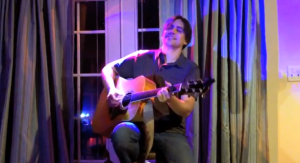
What motivates musicians to join the Concerts in Your Home community?
I think a lot of them are like me, I think they’re fed up with playing places where they’re not paid attention to, and they’ve got to appeal to the lowest common denominator.
One of the key things for me — even though it’s not explicitly stated — when you play in a bar, the value of what you do is measured by how much alcohol is sold. And I think that’s a shitty way to measure music. I don’t have a problem with people drinking, that doesn’t bother me at all. But if the value of what I deliver to people is measured in alcohol sales, I think it’s a pretty shitty way to measure what I do.
What does the music fan get out of it?
The big attraction both for hosts and fans of house concerts is the pin-drop atmosphere. You don’t have the drunk guy behind you talking while you’re trying to listen to music, so it’s movie theater etiquette. And when artists have everyone’s attention, magical things start to happen. It becomes spiritual, it becomes communal, it takes the show to another level. There’s a sort of unity, a “Kumbaya” thing where we’re all one — that starts to be tangible. I think that’s a big part of the appeal to fans, the house concert high: “We were all there, we were a part of something.”
I think a lot of shows inspire a looser atmosphere too, but anything that’s going on has to do with the show. So, even if you have the performer joking around with the people in the second row, or getting their shoe tied by someone in the front row because they’re so close — it all serves the show as opposed to being a distraction.
What is it about the music climate or the music industry right now that has encouraged this living room trend to gain so much traction and popularity?
There’s a couple ways to look at this. Demographically, kids don’t buy CDs. When I was first starting out, the hot market was the CDs you sold to kids. Everyone was trying to be half their age in terms of material and presentation so they could appeal to 16 year-olds and 19 year-olds because those were the people who bought the music.
Well, these people are now in their 40s and 50s — well, I’m not that old — but these empty-nesters are the ones who grew up with the culture of buying a souvenir after the show. So if you’re going to sell CDs, house concerts are one of the last markets left where there are people that still value taking the music home on an artistic medium rather than a hard drive or thumb drive.
When I play colleges, people come up and say, “You’re awesome!” and I say, “Thanks, do you want to buy a CD?” And they say, “No, we’ll just check you out online.” You hear that enough times, and you say, “Well, shit, why am I making all these CDs? Why am I playing for 22 year-olds who don’t want what I need to sell to live?” That is the demographic answer.
But I think with technology, community starts developing over the Internet — the idea of sharing spaces and sharing experiences is another thing that causes the upswing [in house concerts].
Even more important that that is the idea of embracing small — that’s probably the most important part of why house concerts are surging. Twenty years ago, you pretty much went out to a bar, drank, and listened to bands — that’s what you did on weekends. Now you have video games, groups for every interest under the sun. There are more sports on TV and on the field than ever before. There are so many distractions. So we can’t have 400-500 people at the club every weekend listing to original music. You have to figure out ways where if the shows are going to be smaller, how do you make that work? And house concerts are the best example I’ve seen of making it work.
When dealing with professional musicians who are used to professional venues, is there an attitude adjustment that needs to happen before they feel comfortable performing in a living room?
I think it depends. Ellis Paul, because of what he’s accomplished — because he can still sell out small- to medium-sized venues in 30 or 40 markets — he has a different standard. He’s not going to do a house concert for 30 people — you have to have big house. You have to seat 80-100 people at your house to have Ellis Paul play, and even then, it’s tough to get him. So part of that is just the economics of success. You’re going to go where you’re going to be the most productive.
There are artists that feel they should be at the level of Ellis Paul — or maybe once were and are no longer — that are facing the wake up call of, “Okay, I have to learn to make do with less, I have to learn to enjoy to play for smaller crowds.” Some take to it like a duck to water because of the atmosphere, and for some of them, the economics really still bugs them.
To put a finer point on it: Because we encourage so many hosts to start small, the idea of playing for 12 people in a cozy living room, even on a Wendesday night… there are a lot of artists that say, “I can’t do that, I won’t do that.” And that’s fine. They can go play a club and have 12 people there. And then they have to go find a place to stay. (laughs)
The prima donna stuff does not cut it in our market. Fortunately, there are a lot of really talented artists out there who are nice people with decent expectations, and even when they have odd experiences they can handle it gracefully and move on to the next opportunity and the next day.
This is not a perfect world. We have people who try to host concerts and fail. There are some who will schedule a show and cancel it a few weeks out. We have 20-30 new hosts each month that we train and coach to try and get them on the right foot, and not all of them succeed.
It sounds like you’re very hands-on with the hosts…
Oh yeah, we’re hands on with everybody. Everyone who joins the site has a conversation with us. We don’t have the money for background checks. We try to get a sense of why they’re doing it and make sure they know what they’re getting into and their responsibilities. That slows things down, but we think it’s a really important thing, especially when we have 22-year old women touring by themselves, we don’t want this site to be anonymous.
Where do you want to take living room concerts next?
We started a new website called BenefitArtists.com which basically allows us to tie artists together with charities. The charities help us build an audience and we help them raise money. We connect charities with artists who have an affinity for that cause, so it’s a win-win situation. An artist gets to support a cause they love, and they help the host build an audience.
Listening Room Network is becoming our fan portal. Within the next few months that’s going to really develop in terms of creating a house concert club. If you’re into this experience you’re going to be able to meet people with similar interests and connect with all the house concerts in your area.
Our goal here is to get our community to the point where we have all these hubs that develop organically, where artists can book a tour off of one conversation. They get connected with the right host, who’s connected with the other hosts, and the artist will book five or ten shows with one contact. To me, that’s where this needs to go, because booking is impossible. It’s ridiculously draining, and we have all these artists spending more time booking and doing social media than they are on their music. To me, that is a huge loss. We [musicians] are terrible at booking, we hate it. What I’m trying to do is create a system where the fans are enabled and empowered to make it happen and to do it through community. Everyone else out there is trying to do it through technology, we’re trying to do it through community.
Visit Concerts in Your Home.

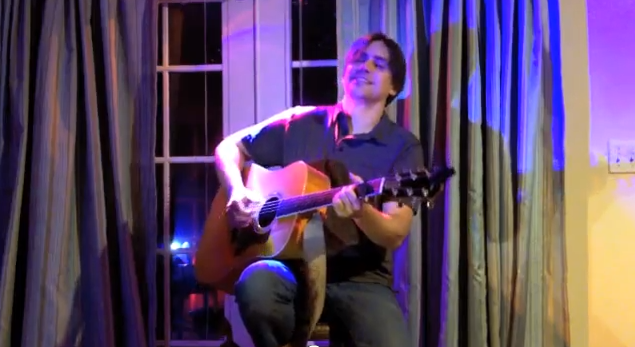
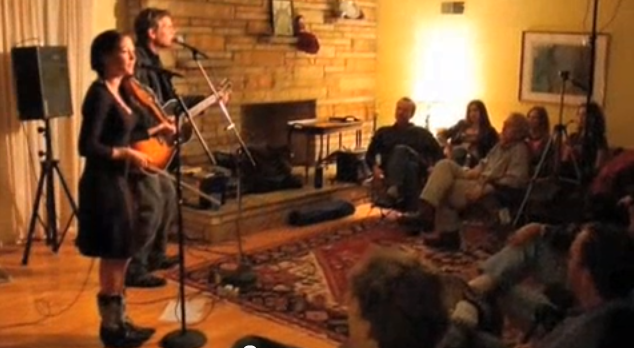
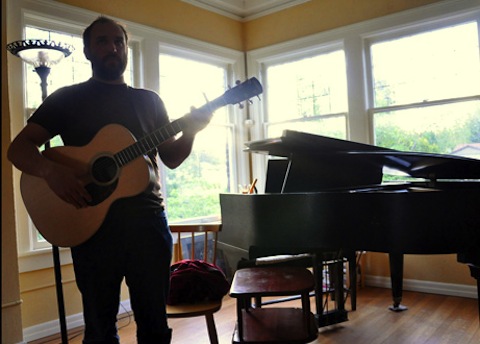
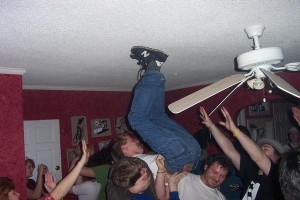 Most of today’s unsigned, independent bands that have toured the country with no booking agent and no management have played their share of living rooms. I know I have. But these living rooms are not often the kind of urbane, sitting-down affairs you see Bazan playing for 30-somethings. Rather, the hybrid living room/venue is rooted in “punk houses” where a bunch of high school and college-age music fans get together to hang out, party and host local and touring bands. I can honestly say from personal experience these house shows are some of the most fun and inspiring shows I’ve ever played. Our fans have crowdsurfed into ceiling fans more than once (pictured here). But the reason these shows are so memorable has just as much to do with the performance as it does with the camaraderie of being able to meet and entertain people in their homes.
Most of today’s unsigned, independent bands that have toured the country with no booking agent and no management have played their share of living rooms. I know I have. But these living rooms are not often the kind of urbane, sitting-down affairs you see Bazan playing for 30-somethings. Rather, the hybrid living room/venue is rooted in “punk houses” where a bunch of high school and college-age music fans get together to hang out, party and host local and touring bands. I can honestly say from personal experience these house shows are some of the most fun and inspiring shows I’ve ever played. Our fans have crowdsurfed into ceiling fans more than once (pictured here). But the reason these shows are so memorable has just as much to do with the performance as it does with the camaraderie of being able to meet and entertain people in their homes.